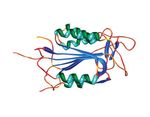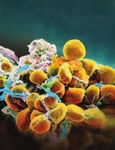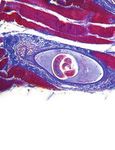Case Report Psychiatric Symptoms due to Thyroid Disease in a Female Adolescent
←
→
Page content transcription
If your browser does not render page correctly, please read the page content below
Hindawi Publishing Corporation
Case Reports in Endocrinology
Volume 2014, Article ID 972348, 4 pages
http://dx.doi.org/10.1155/2014/972348
Case Report
Psychiatric Symptoms due to Thyroid Disease in
a Female Adolescent
Nelly Capetillo-Ventura1 and Inmaculada Baeza2
1
Department of Psychiatry, “Dr. José Eleuterio González” University Hospital, UANL, Avenida Francisco I. Madero
and Avenida Gonzalitos, Mitras Centro, 64460 Monterrey, NL, Mexico
2
Department of Child and Adolescent Psychiatry and Psychology, Institut Clı́nic de Neurociencies, Hospital Clı́nic,
IDIBAPS, CIBERSAM, Barcelona, Spain
Correspondence should be addressed to Nelly Capetillo-Ventura; dranellycv@hotmail.com
Received 27 July 2014; Revised 5 October 2014; Accepted 9 October 2014; Published 4 November 2014
Academic Editor: Masashi Demura
Copyright © 2014 N. Capetillo-Ventura and I. Baeza. This is an open access article distributed under the Creative Commons
Attribution License, which permits unrestricted use, distribution, and reproduction in any medium, provided the original work is
properly cited.
The hypothalamic-pituitary-thyroid axis is involved in the production of thyroid hormone which is needed to maintain the normal
functioning of various organs and systems, including the central nervous system. This study reports a case of hypothyroidism in
a fifteen-year-old female adolescent who was attended for psychiatric symptoms. This case reveals the importance of evaluating
thyroid function in children and adolescents with neuropsychiatric symptoms.
1. Background hypothyroidism in a female adolescent who was attended for
psychiatric symptoms.
The hypothalamic-pituitary-thyroid axis is involved in the
production of thyroid hormone which is needed to main-
tain the normal functioning of various organs and sys- 2. Case Report
tems, including the central nervous system [1]. Both
hypothyroidism and hyperthyroidism can cause symptoms A fifteen-year-old female adolescent was admitted to the
attributable to psychiatric illness. The lack of pathognomonic child and adolescent acute psychiatric unit of our hospital for
symptoms to differentiate thyroid disease from psychiatric the first time after remaining isolated in her home for four
disorders makes it difficult to distinguish between the two months. She had initiated treatment in the outpatient clinic of
conditions in some cases [2]. her district in June 2013, attending only one visit and refusing
Hypothyroidism is the most common abnormality of all psychiatric treatment thereafter.
thyroid function in children and adolescents [3]. The preva- There was a family history of schizophrenia in second
lence of thyroid dysfunction between 11 and 18 years is 1% degree relative on her mother’s side. The patient’s medical
and the most common cause of acquired hypothyroidism history, according to her family, included recurrent acute
is chronic lymphocytic thyroiditis (Hashimoto’s thyroiditis), bronchitis until 10 years of age. No history of alcohol or
with a 2 : 1 female predominance, and, secondly, endemic tobacco consumption or psychoactive substance use was
goiter due to iodine deficiency. Hypothyroidism in children reported. The patient was very selective and restrictive in
can be classified as primary or secondary (central) and her meals since her childhood. She only ate biscuits, ham
can be congenital or acquired and transient or permanent croquettes, bread, and omelettes.
[4]. Regarding school, she described acceptable performance
Most adults with Hashimoto’s thyroiditis are asymp- until the previous academic year when she presented some
tomatic [5]. There are few published articles about this issue difficulties, and her teachers decided to change her to another
in children and adolescents. This paper reports a case of classroom with a lower academic level.2 Case Reports in Endocrinology
Her premorbid personality was described as quiet and (5 mg/day) and vitamin D (0.266 mg/alternate days) supple-
shy, with some difficulty in social relationships, but with a mentation too.
group of friends at the beginning of the episode. She lived During her hospital stay, the patient adapted well to the
with her parents and an 18-year-old sister in a mid-size city rules of the unit, was sociable with peers, and showed no
(with a population of about 216,000 inhabitants). behavioural disturbances at any time.
The patient reported that during the previous academic After 8 days in our acute unit, the patient showed signif-
year she had been separated from her friends due to the icant improvement in mood and social interaction and was
change of classroom and at the same time she had begun to discharged. Monitoring continued in the outpatient clinic,
suffer digestive cramps and headaches, and as a result she while the patient maintained the same pharmacological
stopped going to school. She stayed at home, with no interest treatment. At six weeks, the patient was asymptomatic; she
in leaving the house, playing computer games and surfing had returned to school showing acceptable performance and
the internet all day from April 2013 until her admission in socialization with family and classmates. The new thyroid
our department 6 months later. The family explained that function test showed TSH 9.096 mIU/L and FT4 1.21 ng/dL.
she had also become withdrawn from them, showing little Six-months after discharge, the improvement persisted, and
interest in conversation, giving only monosyllabic answers, thyroid function was TSH 6.935 mIU/L and FT4 1.35 ng/dL
and gesturing in response to her parents’ questions. She and antithyroid peroxidase antibodies decreased, with 75
showed neglect in her personal hygiene and apathy regarding micrograms/day of levothyroxine.
her physical appearance.
At the time of her admission, the mental status examina-
tion showed she was conscious and oriented in time, place, 3. Discussion
and person, though unkempt and exhibiting psychomo-
tor retardation, poor eye contact, and limited language, This paper reports a case of hypothyroidism in a female
answering questions with monosyllables or gestures. She adolescent who was attended for psychiatric symptoms.
also displayed emotional lability when discussing sensitive The literature highlights the importance of measuring thy-
issues like friends and school and showed hypothymia, roid function in patients with refractory mood disorders,
poorly reactive mood, apathy, weakness, and anhedonia and rapid cycling, mixed episodes, and treatment with mood
was only interested in computer usage. She did not exhibit stabilizers (especially lithium) and in whom there is no
impaired sensory perception, self-referentiality, or psychotic improvement after treatment is initiated. In our department,
behavior, though she was sleeping from 4:00 am to noon. thyroid function tests are routinely requested for adolescent
Her food intake was very selective, limited to certain specific patients with affective symptoms from the initial assessment
foods, but there was no loss of appetite. The patient denied whenever there are clinical manifestations of hypothyroidism
having suicidal ideation. such as decreased school performance, fatigue and slug-
gishness, emotional lability, and depressed or altered mood.
In the first interview, apathy and depressive moods were
This behavior may simulate other disorders of adolescence
observed when she spoke about life events related to her
[4, 6]. The abnormalities found on physical examination
friends at school and how this situation interfered with
include short stature, apparent excess weight (more fluid
her functioning. Physical examination revealed a weight of
retention than obesity), having a puffy face with a dull,
83.1 kg, height of 1.63 m, body mass index of 31.3, body mass
placid expression, bradycardia, pseudohypertrophy of the
index standard deviation score of 2.689, and blood pleasure
muscles, and delayed deep tendon reflexes. The thyroid
of 120/80 mmHg. She denied muscular pain and no goiter or
gland may be normal in size, not palpable, or diffusely
myxedema.
enlarged [7]. As for the laboratory analysis, determining
Soon after admission, a blood test and electrocardiogram the levels of TSH and FT4 is usually sufficient to make a
(EKG) were performed. EKG, liver function tests, electro- diagnosis. Primary hypothyroidism presents high TSH and
lytes, and whole blood count were within normal limits. low free T4. Secondary hypothyroidism presents with low or
Due to her isolation at home and selective food intake, normal TSH and decreased FT4. Autoimmune thyroiditis is
levels of some vitamins were analyzed; vitamin D3 and folic confirmed by positive antithyroid antibodies (anti-TPO 85–
acid levels were insufficient (vitamin D3: 20.9 ng/mL insuf- 90% higher) but its positivity does not imply hypothyroidism.
ficient with levels above 30 ng/mL and folic acid: 2.3 ng/mL [6]. In the National Health and Nutrition Examination Survey
insufficient with levels above 3 ng/mL). The thyroid func- (NHANES III) from 1988 and 1994, 6.3 percent of adoles-
tion test showed thyroid-stimulating hormone (TSH) levels cents (12 to 19 years of age) had positive antithyroglobulin
of 24.159 mIU/L (reference range: 0.400–4.00), free thy- antibodies (Tg Ab) and 4.8 percent had positive antithyroid
roxine (FT4) 0.93 ng/dL (reference range: 0.80–2.00), and peroxidase antibodies (TPO Ab) [8].
triiodothyronine (T3) 1.08 ng/mL (reference range: 0.70– In paediatrics, the most common age of presentation of
1.90), with antithyroid peroxidase antibodies >1300 IU/mL autoimmune thyroiditis is adolescence, though the disease
(reference range:Case Reports in Endocrinology 3
Thyroid hormones exert their influence on the central TSH and T4 blood levels in the complementary tests for
nervous system through a variety of mechanisms: modula- differential diagnoses.
tion of gene expression of several groups of proteins, some of
them with known physiopathological implications in mood
Abbreviations
disorders and the influence on serotonin and noradrenergic
neurotransmission, known to be one of the modes of action EKG: Electrocardiogram
of antidepressants [11]. TSH: Thyroid-stimulating hormone
T4 is the treatment of choice in children and adoles- FT4: Thyroxine
cents with hypothyroidism. The goals of treatment are to T3: Triiodothyronine.
restore normal growth and development, including puber-
tal development [7]. In patients who present with severe, Consent
longstanding hypothyroidism, slow correction with FT4 is
advisable in order to minimize the potential development of Written informed consent was obtained from the patient and
unwanted side effects (deterioration in school performance, her parents for publication of this case study.
short attention span, hyperactivity, insomnia, and behavioral
difficulties). In such patients, the replacement dose should be
increased slowly over several weeks to months [12]. McClel- Conflict of Interests
land et al. recommended a period of closer observation before The authors have no conflict of interests relevant to this
making any adjustments in the dose of thyroxine in order paper to disclose. The authors have no financial relationships
to detect noncompliance [13]. Several reports indicate that relevant to this paper to disclose.
in hypothyroid patients the thyroid hormone replacement
alleviates depressive symptoms, and thyroid supplements are
accepted as an effective treatment option for affective disor- Authors’ Contribution
ders. The cumulative dose of levothyroxine over preceding
Nelly Capetillo-Ventura conceptualized and drafted the initial
weeks is best reflected in the serum TSH, and noncompliant
paper. Inmaculada Baeza reviewed and revised the paper and
patients require careful education as to the rationale for
approved the final paper submitted. Nelly Capetillo-Ventura
treatment [14]. In the patient we present, the TSH levels
and Inmaculada Baeza approved the final paper submitted
diminished after six weeks of treatment, which means there
and agree to be accountable for all aspects of the work.
was adequate therapeutic compliance and hence clinical
improvement.
The natural course of juvenile autoimmune thyroiditis is References
quite variable, and thyroid functions should be monitored
periodically to detect hypothyroidism in all children and ado- [1] P. M. Yen, “Physiological and molecular basis of Thyroid
hormone action,” Physiological Reviews, vol. 81, no. 3, pp. 1097–
lescents including those who are initially euthyroid or have
1142, 2001.
subclinical hypothyroidism. Patients who are not receiving
[2] F. Bello and S. G. Kojchen, “Función tiroidea y patologı́a
treatment at the time of presentation may require treatment
psiquiátrica,” Boletı́n de la Escuela de Medicina, vol. 29, no. 3,
subsequently. Levothyroxine therapy may have beneficial 2000.
effects on the clinical course of the disease and on antibody
[3] M. L. Rallison, B. M. Dobyns, F. R. Keating, J. E. Rall, and F. H.
titers [15].
Tyler, “Occurrence and natural history of chronic lymphocytic
Diagnosis of hypothyroidism is particularly important in thyroiditis in childhood,” The Journal of Pediatrics, vol. 86, no.
adolescence because this condition retards growth in height 5, pp. 675–682, 1975.
and development of secondary sexual characteristics; delayed [4] M. Bettendorf, “Thyroid disorders in children from birth to
onset of puberty can also occur and diagnosing autoimmune adolescence,” European Journal of Nuclear Medicine, vol. 29, no.
thyroiditis (AT) at an early stage offers the opportunity for 2, pp. S439–S446, 2002.
a timely intervention. Its potential association with papillary [5] E. Sarı, A. Karaoglu, and E. Yes¸ilkaya, “Hashimoto’s thyroiditis
thyroid carcinoma is an additional reason for a careful follow- in children and adolescents,” in Autoimmune Disorders: Current
up of patients with AT [16]. Concepts and Advances from Bedside to Mechanistic Insights, F.-
P. Huang, Ed., InTech, 2011.
4. Conclusions [6] C. Aguilá, “Hipotiroidismo en adolescentes,” Adolescere, vol. 12,
no. 1, pp. 24–31, 2013.
Our case is an example of how neuropsychiatric symptoms [7] S. La Franchi, Acquired Hypothyroidism in Childhood and
in children and adolescents may have their etiology in an Adolescence, UpToDate, 2007.
alteration of the functioning of the hypothalamic-pituitary- [8] J. G. Hollowell, N. W. Staehling, W. Dana Flanders et al., “Serum
thyroid axis. After a proper diagnosis is made, treatment TSH, T4, and thyroid antibodies in the United States population
can focus on controlling the signs and symptoms presented, (1988 to 1994): National Health and Nutrition Examination
thus avoiding overmedication and preventing future com- Survey (NHANES III),” Journal of Clinical Endocrinology and
plications in other body systems. Evaluation of thyroid Metabolism, vol. 87, no. 2, pp. 489–499, 2002.
functioning may be prudent in children and adolescents with [9] T. P. Foley Jr., V. Abbassi, K. C. Copeland, and M. B. Draznin,
neuropsychiatric symptoms, and we recommended including “Brief report: hypothyroidism caused by chronic autoimmune4 Case Reports in Endocrinology
thyroiditis in very young infants,” The New England Journal of
Medicine, vol. 330, no. 7, pp. 466–468, 1994.
[10] A. Monzani, F. Prodam, A. Rapa et al., “Endocrine disorders
in childhood and adolescence. Natural history of subclinical
hypothyroidism in children and adolescents and potential
effects of replacement therapy: a review,” European Journal of
Endocrinology, vol. 168, no. 1, pp. R1–R11, 2013.
[11] S. Gloger, C. Fardella, R. Santis, and J. Bitran, “Relevancia
del estudio tiroideo en pacientes con trastornos psiquiátricos,”
Revista Médica de Chile, vol. 125, pp. 1351–1356, 1997.
[12] R. Brown, “Autoimmune thyroiditis in childhood,” Journal of
Clinical Research in Pediatric Endocrinology, vol. 5, no. 1, pp. 45–
49, 2013.
[13] P. McClelland, A. Stott, and W. Howel-Evans, “Hyperthy-
rotrophinaemia during thyroxine replacement therapy,” Post-
graduate Medical Journal, vol. 65, no. 762, pp. 205–207, 1989.
[14] A. Sevinc and H. Savli, “Hypothyroidism masquerading as
depression: the role of noncompliance,” Journal of the National
Medical Association, vol. 96, no. 3, pp. 379–382, 2004.
[15] S. Özen, Ö. Berk, D. G. Şimşek, and Ş. Darcan, “Clinical course
of Hashimoto’s thyroiditis and effects of levothyroxine therapy
on the clinical course of the disease in children and adolescents,”
JCRPE Journal of Clinical Research in Pediatric Endocrinology,
vol. 3, no. 4, pp. 192–197, 2011.
[16] V. Skarpa, E. Kousta, A. Tertipi et al., “Epidemiological char-
acteristics of children with autoimmune thyroid disease,” Hor-
mones, vol. 10, no. 3, pp. 207–214, 2011.MEDIATORS of
INFLAMMATION
The Scientific Gastroenterology Journal of
World Journal
Hindawi Publishing Corporation
Research and Practice
Hindawi Publishing Corporation
Hindawi Publishing Corporation
Diabetes Research
Hindawi Publishing Corporation
Disease Markers
Hindawi Publishing Corporation
http://www.hindawi.com Volume 2014
http://www.hindawi.com Volume 2014 http://www.hindawi.com Volume 2014 http://www.hindawi.com Volume 2014 http://www.hindawi.com Volume 2014
Journal of International Journal of
Immunology Research
Hindawi Publishing Corporation
Endocrinology
Hindawi Publishing Corporation
http://www.hindawi.com Volume 2014 http://www.hindawi.com Volume 2014
Submit your manuscripts at
http://www.hindawi.com
BioMed
PPAR Research
Hindawi Publishing Corporation
Research International
Hindawi Publishing Corporation
http://www.hindawi.com Volume 2014 http://www.hindawi.com Volume 2014
Journal of
Obesity
Evidence-Based
Journal of Stem Cells Complementary and Journal of
Ophthalmology
Hindawi Publishing Corporation
International
Hindawi Publishing Corporation
Alternative Medicine
Hindawi Publishing Corporation Hindawi Publishing Corporation
Oncology
Hindawi Publishing Corporation
http://www.hindawi.com Volume 2014 http://www.hindawi.com Volume 2014 http://www.hindawi.com Volume 2014 http://www.hindawi.com Volume 2014 http://www.hindawi.com Volume 2014
Parkinson’s
Disease
Computational and
Mathematical Methods
in Medicine
Behavioural
Neurology
AIDS
Research and Treatment
Oxidative Medicine and
Cellular Longevity
Hindawi Publishing Corporation Hindawi Publishing Corporation Hindawi Publishing Corporation Hindawi Publishing Corporation Hindawi Publishing Corporation
http://www.hindawi.com Volume 2014 http://www.hindawi.com Volume 2014 http://www.hindawi.com Volume 2014 http://www.hindawi.com Volume 2014 http://www.hindawi.com Volume 2014You can also read



























































